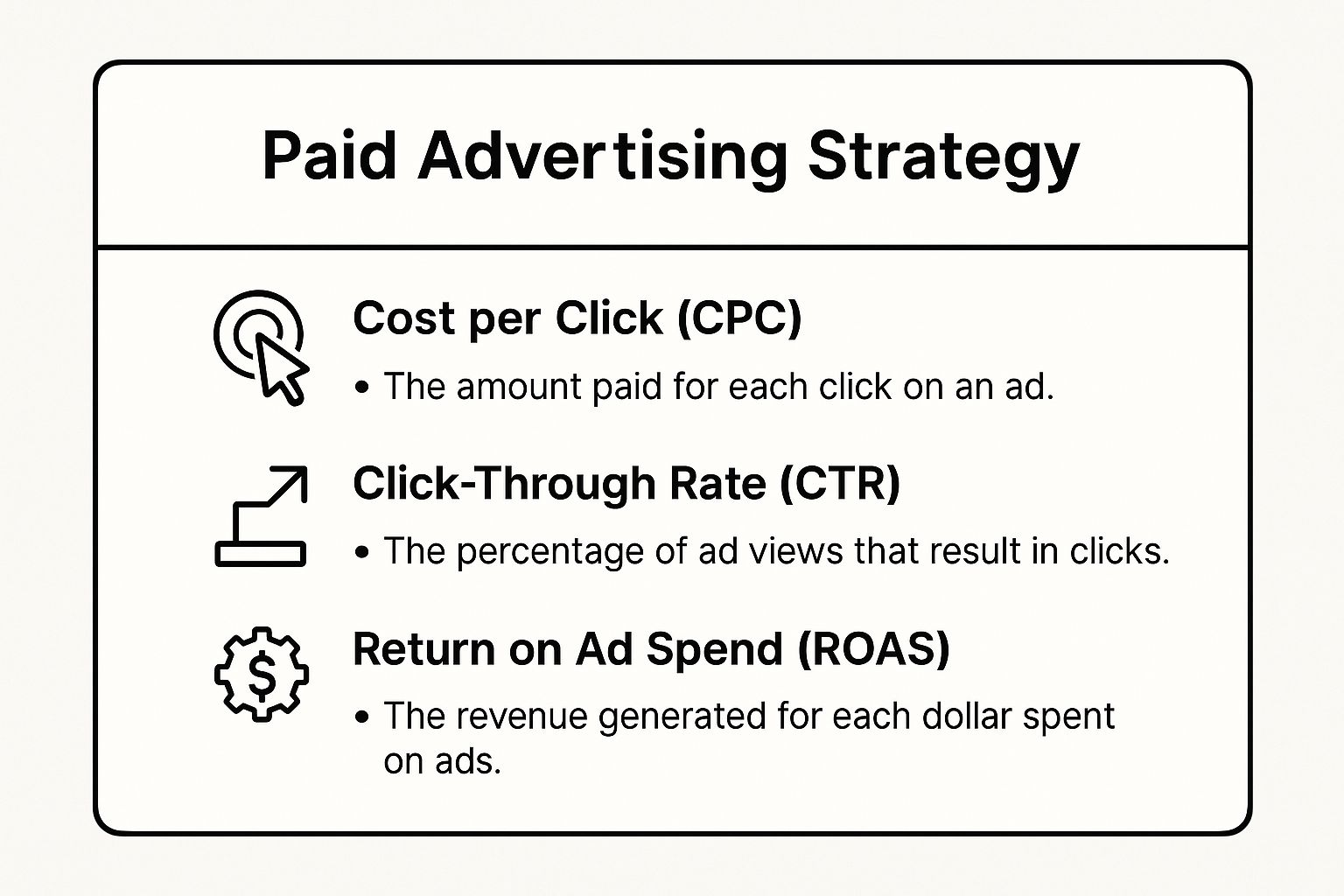Unlock Exponential Growth: Why SaaS Needs Modern Affiliate Marketing
The SaaS landscape is more competitive than ever. While traditional marketing channels see rising costs and diminishing returns, a powerful, often underutilized engine for growth exists: affiliate marketing. But this isn't about outdated banner ads or generic coupon sites. Modern affiliate marketing strategies, especially for SaaS, are about building authentic partnerships and embedding growth levers directly into your product experience. This is crucial for early-stage startups, product-led growth teams, and developers who need scalable, predictable revenue streams without a massive ad spend. The right approach turns loyal users and strategic partners into your most effective and trusted sales force.
This article provides a tactical blueprint for creating a high-impact affiliate program. We move beyond theory to break down 10 proven strategies tailored for SaaS, covering everything from ideation and execution to measurement. You will learn how to:
- Integrate affiliates into your content, email, and video marketing funnels.
- Leverage social proof through influencers and dedicated review sites.
- Harness paid ads and SEO to amplify your partners' promotional efforts.
- Utilize webinars and podcasts for high-engagement, expert-led promotions.
Each strategy is presented with actionable steps and practical examples to help you build a program that generates tangible results. The affiliate model has evolved significantly, and understanding its current state is key to success. For a detailed breakdown of current trends, consider these 10 effective affiliate marketing strategies for 2025. Prepare to transform your approach from a simple referral system into a sophisticated, multi-channel growth engine.
1. Content Marketing Strategy
At its core, a content marketing strategy involves creating and distributing valuable, relevant, and consistent content to attract and retain a clearly defined audience. This approach positions you as a trusted authority rather than just a salesperson. Instead of directly pushing products, you focus on solving your audience's problems, which naturally leads to opportunities to recommend solutions, like SaaS products, through affiliate links. This is one of the most sustainable affiliate marketing strategies because it builds a long-term relationship with your audience, fostering trust that translates into higher, more consistent conversion rates.

How to Implement This Strategy
A successful content marketing approach is systematic. Start by identifying the specific pain points of your target audience, such as early-stage SaaS founders struggling with user onboarding. Use keyword research tools to discover what questions they are actively searching for answers to. This data becomes the foundation for your content calendar.
Create comprehensive content that directly addresses these issues. This could take the form of in-depth tutorials, detailed product comparisons, or case studies. For instance, a blog post titled "The Top 5 User Onboarding Tools for SaaS in 2024" can organically feature your affiliate links within a context that provides immense value. Pat Flynn of Smart Passive Income masterfully uses this method, integrating recommendations for software and courses into his educational content for entrepreneurs.
Why This Approach Works
This strategy excels because it aligns with modern consumer behavior. Audiences are skeptical of direct advertising but actively seek out expert advice and authentic recommendations. By providing genuine help first, you lower their guard and build credibility. When you recommend a SaaS tool, it’s perceived as a trusted suggestion from an expert, not a sales pitch. This approach is ideal for affiliates who want to build a sustainable brand and a loyal community, making it a powerful long-term play in the affiliate marketing landscape.
2. Email Marketing Strategy
An email marketing strategy centers on building and nurturing a dedicated email list to promote affiliate products through targeted campaigns, newsletters, and automated sequences. This approach bypasses algorithm-dependent platforms like social media and search engines, giving you a direct line of communication with your audience. By delivering personalized value straight to their inbox, you can cultivate deep, trust-based relationships that make your affiliate recommendations feel like advice from a friend. This is one of the most powerful affiliate marketing strategies because it provides control, direct access, and the ability to segment and personalize offers for maximum impact.

How to Implement This Strategy
The foundation of this strategy is a valuable lead magnet, such as a free ebook, webinar, or checklist, that incentivizes visitors to subscribe to your email list. Once you have subscribers, focus on nurturing the relationship. Amy Porterfield, a renowned online marketing expert, excels at this by providing consistent, high-value content through her newsletters before ever pitching a product.
Implement an automated welcome sequence to introduce new subscribers to your brand and provide initial value. From there, segment your list based on user behavior, such as which links they click or content they engage with. This allows you to send highly targeted promotions. For example, you can send a special offer for a SaaS project management tool only to subscribers who have shown interest in productivity content. To enhance your email marketing strategy, consider reviewing various effective email marketing examples that showcase successful campaign structures and personalization techniques.
Why This Approach Works
Email marketing is effective because it's a permission-based channel. Subscribers have explicitly opted in to hear from you, making them far more receptive to your messages than a cold audience. This direct relationship fosters a sense of community and trust that is difficult to achieve on other platforms. The ability to segment and personalize communications means you can deliver the right SaaS recommendation to the right person at the right time, dramatically increasing conversion rates. It is an ideal strategy for affiliates focused on building a long-term, profitable asset that isn't vulnerable to external platform changes.
3. YouTube Video Marketing Strategy
A YouTube video marketing strategy leverages the world's second-largest search engine to promote affiliate products through engaging visual content. This approach involves creating videos that review, demonstrate, or compare SaaS tools, allowing you to showcase their features and benefits in a dynamic format. You build a personal connection with your audience through your on-screen presence, which establishes trust and authority. This is one of the most effective affiliate marketing strategies for products that benefit from a visual explanation, as you can directly show how a tool solves a specific problem.
How to Implement This Strategy
To execute this strategy, start by identifying SaaS products that align with your niche and have a strong visual component, like a user interface or workflow. Your content can take many forms, including in-depth tutorials, "first look" feature breakdowns, or comparison videos pitting multiple tools against each other. For example, a video titled "Figma vs. Sketch: Which is Best for UI Design in 2024?" can walk viewers through the pros and cons of each, with affiliate links in the description for both.
Invest in high-quality audio first; viewers will tolerate mediocre video quality but will click away from poor sound. Create compelling thumbnails and titles that spark curiosity and clearly communicate the video's value. Inside the video, include clear verbal calls-to-action, directing viewers to the affiliate links you've placed in the description box and pinned comment. Tech reviewer Marques Brownlee (MKBHD) is a prime example of this, seamlessly integrating product discussions and links into high-value content.
Why This Approach Works
This strategy works because video is an incredibly powerful medium for demonstration and connection. Viewers can see the SaaS product in action, which removes uncertainty and helps them visualize how it could fit into their own workflow. The human element of seeing and hearing you builds a parasocial relationship, making your recommendations feel more like advice from a knowledgeable friend than a sales pitch. It’s ideal for affiliates who are comfortable on camera and want to tap into a massive, highly engaged audience that actively searches for solutions and product reviews on YouTube.
4. Social Media Influencer Strategy
A social media influencer strategy leverages the authority and reach of individuals with a strong online following to promote products. Instead of traditional ads, this approach relies on authentic, personal recommendations shared directly with an engaged audience. Influencers integrate SaaS tools into their content, showing how a product solves a real problem within their niche, whether that's business, productivity, or creativity. This is one of the most effective affiliate marketing strategies for reaching targeted demographics because it taps into the trust that influencers have already built with their followers, making endorsements feel more like genuine advice from a friend.

How to Implement This Strategy
To execute this strategy, begin by identifying influencers whose audience aligns perfectly with your ideal SaaS customer. For a project management tool, you'd target productivity coaches or business mentors on platforms like LinkedIn or YouTube. Don't just look at follower count; prioritize engagement rates and audience demographics.
Reach out with a personalized offer that includes affiliate links and a unique discount code for their followers. For example, a fitness influencer promoting a nutrition planning SaaS could share behind-the-scenes content of them using the app for their meal prep, then share their affiliate link in their Instagram Stories or bio. Business mogul Gary Vaynerchuk often promotes tools he genuinely uses to his entrepreneurial audience, seamlessly weaving them into his keynote clips and social media posts. For those exploring cutting-edge approaches, consider delving into specific strategies to monetize AI influencers and integrate them into your affiliate campaigns.
Why This Approach Works
This strategy is powerful because it bypasses the ad-fatigue common among today's consumers. An influencer's recommendation carries significant social proof and perceived authenticity. When followers see someone they admire succeeding with a specific SaaS tool, they are more inclined to believe it can work for them too. It’s a direct line to a highly relevant and receptive audience. This method is ideal for SaaS brands aiming for rapid, targeted exposure and high-impact conversions. You can find more information about how to recruit influencers and affiliates on Refgrow.com to build out your program.
5. Paid Advertising Strategy
While content-driven approaches build momentum over time, a paid advertising strategy offers immediate, targeted traffic to your affiliate offers. This method involves using platforms like Google Ads, Facebook Ads, or native advertising networks to run campaigns that direct potential customers to your affiliate products. Instead of waiting for organic discovery, you actively place your message in front of a handpicked audience, making it one of the most scalable affiliate marketing strategies for affiliates with a budget who need to test offers and generate revenue quickly.
This infographic summarizes the key metrics you'll need to monitor to ensure your paid campaigns are profitable and efficient.
 By carefully balancing your cost per click (CPC) against your click-through rate (CTR) and overall return on ad spend (ROAS), you can create a profitable and predictable revenue stream.
By carefully balancing your cost per click (CPC) against your click-through rate (CTR) and overall return on ad spend (ROAS), you can create a profitable and predictable revenue stream.
How to Implement This Strategy
Success with paid advertising hinges on precision and optimization. Begin by creating dedicated landing pages specifically for your ad traffic. These pages should be highly focused, with a clear call-to-action that guides visitors to the affiliate offer. For example, an affiliate promoting a project management SaaS could run a Google Ads campaign targeting the keyword "best kanban board software" and direct traffic to a landing page comparing the top three options, each with an affiliate link.
Start with a small, controlled budget to test different ad creatives, targeting parameters, and landing page variations. Digital marketing pioneers like Ryan Deiss and Molly Pittman champion this test-and-scale approach. Once you identify a winning combination that delivers a positive ROAS, you can strategically increase your ad spend to scale up your earnings. It is also crucial to use retargeting pixels to re-engage visitors who showed interest but didn't convert initially.
Why This Approach Works
Paid advertising is effective because it provides speed and control. You can turn traffic on and off like a faucet, allowing for rapid testing of different SaaS products, offers, and messaging. This makes it ideal for affiliates who want to validate an offer's potential before investing heavily in long-term content creation. Furthermore, the granular targeting capabilities of platforms like Facebook Ads allow you to reach hyper-specific audiences, such as "SaaS founders in North America interested in product analytics," ensuring your ad spend is highly efficient. This direct approach offers immediate feedback and, when managed correctly, can produce a predictable and scalable source of affiliate income. To dive deeper into managing these campaigns, you can explore more on effective program management on refgrow.com.
6. SEO and Organic Search Strategy
An SEO and organic search strategy involves optimizing your website and content to rank highly in search engine results pages (SERPs). This method focuses on attracting users who are actively searching for information, reviews, or solutions related to the SaaS products you promote. By capturing this high-intent organic traffic, you connect with an audience at the exact moment they are considering a purchase, making it one of the most powerful affiliate marketing strategies for driving qualified leads.
How to Implement This Strategy
Successful SEO implementation requires a deep understanding of what your target audience is searching for. Begin by conducting keyword research to identify terms with commercial or informational intent, such as "best project management software for small teams" or "how to automate client onboarding." These long-tail keywords often have lower competition and higher conversion rates.
Build your content around these keywords, creating comprehensive and authoritative pieces like in-depth product reviews, comparison articles, or step-by-step guides. For example, a site like TechRadar dominates the technology space by creating detailed "best of" lists and reviews that rank for thousands of product-related searches. To further boost your rankings, focus on building high-quality backlinks from relevant websites and ensure your site is technically sound, with fast page speeds and mobile-friendliness.
Why This Approach Works
This strategy is effective because it targets users with explicit buying intent. Unlike passive audiences on social media, visitors from search engines are actively seeking a solution to their problem. When your content provides the answer and a relevant affiliate recommendation, the path to conversion is short and natural. This method builds long-term, sustainable traffic that isn't dependent on ad spend. By establishing your site as a trusted resource in search results, you create a consistent stream of affiliate revenue and build a durable digital asset. To effectively measure the impact of your SEO efforts, it's crucial to track specific affiliate marketing metrics tailored to this strategy.
7. Review and Comparison Website Strategy
A review and comparison website strategy involves creating a dedicated online resource that offers detailed product analysis, side-by-side comparisons, and comprehensive buying guides. This approach positions your website as the go-to authority for consumers looking to make informed purchasing decisions within a specific niche. By providing objective, in-depth information, you build trust and guide users toward the best solution for their needs, earning commissions through strategically placed affiliate links. This is one of the most powerful affiliate marketing strategies for capturing high-intent traffic, as users are already in the final stages of the buying cycle.
How to Implement This Strategy
To execute this strategy, start by selecting a narrow niche you can dominate, such as "project management software for small creative agencies" or "CRM tools for solo freelancers." The key is to go deep, not wide. Your primary task is to get hands-on experience with the SaaS products you review. Sign up for free trials, pay for a month of service, and use the tools as an actual customer would. This firsthand knowledge is your biggest asset and what separates you from generic content farms.
Develop structured, comprehensive reviews that cover key features, pricing, user experience, and customer support. Create comparison tables that allow users to quickly see the differences between top contenders. For instance, a site like Digital Camera World excels by not just reviewing cameras but by comparing them in specific use-case scenarios. Similarly, your SaaS review site should answer questions like "Which tool is better for team collaboration?" and provide visual evidence through screenshots and short video clips.
Why This Approach Works
This strategy is highly effective because it directly serves users with strong commercial intent. Someone searching for "Asana vs. Trello" is not just browsing; they are actively looking to make a purchase decision. By providing a clear, well-researched, and unbiased answer, you capture that user at the most critical point in their journey. This approach, famously perfected by platforms like Wirecutter and OutdoorGearLab, builds immense authority and credibility. It works exceptionally well for affiliates who enjoy deep-diving into products and can translate complex features into practical pros and cons for their audience, resulting in high conversion rates and substantial affiliate income.
8. Webinar and Online Event Strategy
A webinar and online event strategy leverages live, interactive presentations to educate an audience and seamlessly introduce affiliate products. Instead of a static blog post, this method creates a dynamic, engaging environment where you can build a direct relationship with attendees. You deliver significant value upfront through training or workshops, establishing authority and trust before ever mentioning a product. This positions the SaaS tool you're promoting not as a sale, but as the logical next step for attendees to implement what they've just learned, making it one of the most effective affiliate marketing strategies for high-ticket conversions.
How to Implement This Strategy
The key to a successful webinar is providing genuine value before the pitch. Structure your event around a specific problem your audience faces. For example, host a free workshop on "How to Automate Your Client Onboarding Process" and dedicate the first 45 minutes to actionable, tool-agnostic advice. Only in the final segment do you demonstrate how a specific SaaS product (your affiliate) automates this process perfectly.
To maximize engagement, incorporate interactive elements like live Q&A sessions, polls, and chat discussions. Amy Porterfield is a master of this, using her webinars to teach marketing concepts before transitioning to a pitch for a program or tool. Always offer an exclusive, time-sensitive bonus for attendees who purchase through your link, such as a personal setup template or a one-on-one consultation call. This creates urgency and significantly boosts conversion rates.
Why This Approach Works
This strategy excels because it combines education with a sense of community and urgency. Live events create a captive audience, allowing you to address objections in real-time and build a stronger connection than written content alone can achieve. The act of showing up for a scheduled event means attendees are already highly invested and motivated to solve their problem. When you present a SaaS solution within this educational context, it’s viewed as expert guidance, not a hard sell. This makes it ideal for promoting more complex or higher-priced SaaS products where a detailed demonstration can make all the difference.
9. Podcast Sponsorship and Integration Strategy
The podcast sponsorship and integration strategy leverages the intimate and trust-based relationship between a podcast host and their audience. This method involves promoting affiliate products, including SaaS tools, through sponsored segments, natural product mentions, or even dedicated review episodes. Listeners often view hosts as trusted friends or mentors, making their recommendations highly influential. Instead of a disruptive ad, an affiliate mention becomes a valuable suggestion from a credible source, making it one of the most effective affiliate marketing strategies for reaching engaged, niche audiences.
How to Implement This Strategy
Implementation can take two forms: starting your own podcast or sponsoring an existing one. If you create your own show, you can seamlessly integrate affiliate promotions. For instance, while discussing productivity workflows for founders, you could mention a project management SaaS you use and provide a unique affiliate link or promo code in the show notes. This allows for complete control over the messaging and context.
Alternatively, sponsoring an established podcast in your niche provides instant access to a built-in, loyal audience. When choosing a podcast, vet its audience demographics and engagement to ensure alignment with your target customer. Work with the host to craft an ad read that feels authentic. For example, a sponsorship on a developer-focused podcast could include the host sharing a personal story about how a specific API monitoring SaaS saved them hours of debugging time.
Why This Approach Works
This strategy capitalizes on the power of audio and authentic storytelling. Unlike visual ads that can be easily ignored, podcast recommendations are delivered directly to the listener's ears, often during focused activities like commuting or exercising. The endorsement feels personal and carries the weight of the host's credibility. Tim Ferriss masterfully uses this on The Tim Ferriss Show, where he shares his personal experiences with products, making his promotions feel like genuine advice rather than a sales pitch. This high-trust environment leads to impressive conversion rates, especially for complex SaaS products that benefit from a detailed, story-driven explanation.
10. Coupon and Deal Website Strategy
The coupon and deal website strategy capitalizes on a high-intent audience actively seeking discounts. By creating a dedicated platform or contributing to an existing one that aggregates promotional codes and special offers, you attract consumers who are at the final stage of their purchasing journey. These users are not just browsing; they are looking for a reason to complete a transaction. This is one of the most direct affiliate marketing strategies, as it converts bargain-hunting traffic into sales by providing immediate, tangible value through discounts.
How to Implement This Strategy
To implement this strategy, you can either build your own coupon website or partner with established platforms. Start by building relationships with affiliate managers of SaaS companies to gain exclusive access to deals. Your primary task will be to curate and verify these offers to ensure they are active and provide genuine value, which is crucial for building user trust.
Organize your site logically, with clear categories for different software types, and highlight time-sensitive offers to create a sense of urgency. For example, a "Software Deals" section could feature a limited-time 40% discount on a project management tool. Platforms like Slickdeals thrive on community-driven deal sharing, while Honey (now part of PayPal) perfected this model with a browser extension that automatically applies coupons at checkout, showcasing the power of seamless integration.
Why This Approach Works
This strategy is effective because it targets users with strong purchase intent. A shopper looking for a coupon is already committed to buying; they just need a final push. By providing that discount, you become the last click in their journey, securing the affiliate commission. It’s a high-volume, transactional approach that works exceptionally well for well-known SaaS products with brand recognition. This method is ideal for affiliates who excel at generating traffic and want to capitalize on the powerful psychological driver of finding a good deal, making it a highly effective, conversion-focused strategy.
Affiliate Marketing Strategies Comparison Table
| Strategy | 🔄 Implementation Complexity | ⚡ Resource Requirements | 📊 Expected Outcomes | 💡 Ideal Use Cases | ⭐ Key Advantages |
|---|---|---|---|---|---|
| Content Marketing Strategy | Medium to high (consistent creation, strong writing) | Moderate (content production, SEO skills) | Long-term steady growth in authority and revenue | Building trust and authority over time | Builds credibility; SEO benefits; passive income |
| Email Marketing Strategy | Medium (list building, compliance) | Moderate (email tools, copywriting) | High conversion rates; direct communication | Personalized promotions to segmented audiences | Direct channel; high ROI; personalized targeting |
| YouTube Video Marketing Strategy | High (video production, editing) | High (equipment, editing skills) | High engagement; long-term discovery | Visual product demos and reviews | High engagement; visual product showcasing; multiple monetization |
| Social Media Influencer Strategy | Medium to high (constant content, platform knowledge) | Moderate to high (content creation, multi-platform) | Fast engagement, viral potential | Authentic lifestyle product integration | High engagement; younger audience reach; real-time interaction |
| Paid Advertising Strategy | High (ad creation, testing, expertise) | High (ad spend, analytics tools) | Fast results; scalable traffic | Immediate traffic and targeted offers | Fast, scalable; precise targeting; measurable ROI |
| SEO and Organic Search Strategy | High (technical SEO, content optimization) | Moderate to high (SEO tools, technical skills) | Long-term, sustainable organic traffic | Ranking for high-intent keywords | Free traffic; trust from organic rankings; compound growth |
| Review and Comparison Website | High (in-depth research, product testing) | Moderate to high (testing, content creation) | High conversion rates; niche authority | Niche product reviews and buying guides | High conversions; evergreen content; strong SEO potential |
| Webinar and Online Event Strategy | High (presentation skills, tech setup) | Moderate (webinar platforms, promotion) | High engagement and conversions | Education combined with product pitches | Builds trust; addresses objections live; repurposable content |
| Podcast Sponsorship Strategy | Medium (episode production, integration) | Moderate (recording, editing tools) | High trust; intimate audience connection | Host endorsement for affiliate products | Strong trust; engaged listeners; multiple ad formats |
| Coupon and Deal Website Strategy | Medium (content curation, updating) | Moderate (deal sourcing, site maintenance) | High conversion from bargain hunters | Attracting price-sensitive customers | High-intent traffic; recurring visitors; multiple merchant partnerships |
From Strategy to Scale: Implementing Your Affiliate Growth Engine
We've journeyed through ten distinct yet interconnected affiliate marketing strategies, each offering a unique pathway to scalable growth for your SaaS business. From the foundational power of content and SEO to the high-impact engagement of webinars and the targeted reach of paid advertising, it's clear that modern affiliate marketing is far more than a simple link-sharing exercise. It's a sophisticated discipline built on strategic partnerships, authentic value delivery, and meticulous performance tracking.
The sheer number of options can feel overwhelming, but the goal isn't to boil the ocean. True success lies not in attempting all ten strategies simultaneously, but in making deliberate, informed choices. Your initial focus should be on strategic alignment: which approach resonates most deeply with your ideal customer profile, your brand's voice, and your available resources? A developer-focused API product might find immense success with technical content and podcast integrations, while a user-friendly design tool could thrive with YouTube tutorials and social media influencers.
Distilling the Core Principles for Success
Regardless of the specific channels you choose, several core principles underpin all successful affiliate programs. Mastering these concepts will be the true differentiator between a program that merely exists and one that actively drives significant, predictable revenue.
- Partnership over Transaction: The most fruitful affiliate marketing strategies treat affiliates as genuine partners, not just commission-based salespeople. Invest in building relationships. Provide them with the assets, insights, and support they need to succeed, because their success is inextricably linked to yours. This means creating detailed briefs, offering early access to features, and maintaining open lines of communication.
- Authenticity is Non-Negotiable: Today's audiences can spot a disingenuous promotion from a mile away. Encourage your affiliates to integrate your product naturally into their existing content and workflows. The most powerful endorsements come from creators who genuinely use and believe in your solution, and their audiences can tell the difference.
- Data-Driven Iteration: Your affiliate program should not be a "set it and forget it" initiative. The strategies we've discussed require constant monitoring and optimization. Track which affiliates drive the most qualified trials, which channels yield the highest lifetime value customers, and which promotional assets convert best. Use this data to double down on what works and refine or eliminate what doesn't.
Your Actionable Roadmap to Launch
To move from theory to execution, you need a clear, phased approach. Avoid analysis paralysis by breaking down your launch into manageable steps.
- Select Your Pilot Strategy: Choose just one or two strategies from this list that offer the best fit for your SaaS. Prioritize the one where you have a natural advantage, whether it's an existing content library, a strong social media presence, or a network of potential podcast partners.
- Define Your Ideal Affiliate Persona: Just as you have an ideal customer profile, define your ideal affiliate. Are they a blogger, a YouTuber, a consultant, or an agency? What is their audience size and engagement level? Being specific here will make your recruitment efforts far more effective.
- Build Your Foundational Toolkit: Before you reach out to a single potential partner, prepare your affiliate toolkit. This should include your commission structure, payment terms, tracking links, brand guidelines, and a library of high-quality creative assets (logos, banners, screenshots, and talking points).
- Recruit and Onboard Your First Cohort: Begin targeted outreach to your ideal affiliates. Personalize your approach, highlighting why a partnership would be mutually beneficial. Once they're on board, provide a seamless onboarding experience that gets them up and running quickly.
By starting small, focusing on quality partnerships, and relentlessly measuring your results, you transform affiliate marketing from a line item into a powerful, sustainable growth engine. This channel provides a unique opportunity to build a diverse and resilient acquisition model that scales directly with your success, turning your biggest fans into your most effective advocates.
Ready to implement these strategies without the technical headaches? Refgrow provides a native, embeddable affiliate platform designed specifically for modern SaaS companies. You can manage partnerships, track performance, and handle payouts seamlessly, all from within your own product.
Explore Refgrow and launch your affiliate program in minutes.

